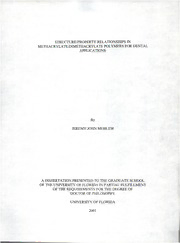
Structure/property relationships in methacrylate/dimethacrylate polymers for dental applications PDF
Preview Structure/property relationships in methacrylate/dimethacrylate polymers for dental applications
STRUCTURE/PROPERTYRELATIONSHIPSIN METHACRYLATE/DIMETHACRYLATEPOLYMERSFORDENTAL APPLICATIONS By JEREMYJOHNMEHLEM ADISSERTATIONPRESENTEDTOTHEGRADUATESCHOOL OFTHEUNIVERSITYOFFLORIDAINPARTIALFULFILLMENT OFTHEREQUIREMENTSFORTHEDEGREEOF DOCTOROFPHILOSOPHY UNIVERSITYOFFLORIDA 2001 [Thisdissertationisdedicatedtoallofthosewhogavetheirloveandsupportduringthe writingofthedissertation,especiallymywifeKacy.] ACKNOWLEDGMENTS Iwouldliketothankmyadvisoranddoctoralcommittee,Dr.AnthonyBrennan, withoutwhoseenthusiasm,knowledge,andguidancenoneofthiswouldbepossible. I wouldalsoliketothankthemembersofthesupervisorycommitteefortheirvaluable input:Dr.ElliotDouglas,Dr.ChristopherBatich,Dr.RonaldBaney,andDr.Kenneth Wagener. Icannotthankenoughallofmycolleagueswhogavethesupportand collaborationnecessarytomakeitthroughthisonerousprocess: MarkSchwarz,Jennifer Russo,JeanneMacdonald,Dr.LuxsameePlangsangmas,XiaomeiQian,DerekLincoln, ArthurGavrin,JamieRhodes,LeeZhao,Dr.BrentGila,Dr.DrewAmery,BobHadba, Dr.ChrisWidenhouse,Dr.RodrigoOrifice,Dr.JamesMarrotta,andPaulMartin. I wouldalsoliketothankthenextgenerationofcolleaguesforbringingnewideasand perspectivestoourdiscussions: ClaytonBohn,AdamFeinberg,WadeWilkerson,Nikhil Kothurkar,AmyGibson,CharlesSeegert,LeslieWilson,BrianHatcher,BrendanHauser, BryanCuevas,JoshStopek,andalltheotherstudents,faculty,andstaffthatmademy experienceattheUniversityofFloridamemorable. IcannotexpressenoughgratitudetoDr.JesseArnold,Dr.TomMillerandDr. MikeZamorafortheirguidanceearlyinmycareerasagraduatestudentandtheir continuedadviceasIgointotheworkplace. SpecialthanksgoesouttoMs.TonyaBrevaldiforherhelpwithNMR spectroscopyandMrs.JeanneMacdonaldforherhelpwithDSCmeasurements. Iwould iii alsoliketothankDr.C.RussellBowersandhisgraduatestudent,TonyZook,forallof theirhelpmakingl29xenonNMRmeasurements. Icouldnothavecompletedthework withouttheircollaboration. Iwouldberemissnottorecognizetheaidthattheprogramassistantsprovide. I wouldalsoliketothankDr.PeterIfjuforhishelpinmakingmodulusmeasurementon ourstandardsandhisimpromptumentoringatourboardmeetings. ImustacknowledgetheCenterfortheDevelopmentofAlternativestoDental AmalgamattheUniversityofFlorida,especiallyMr.BenLeeinthedentalbiomaterials laboratoryandtheNIH-NIDR(grantno.2-P50-DE09307)forfundingmyresearchand allowingmetheopportunitytoattendandpresentmyworkatnationalconferences. Iwouldliketothankmyparentsandfamilyforsupportingmycontinuededucation. Last,butnotleast,Iwouldliketothankmywife,Kacy,forherloveandsupportthrough thelastyearsofmyeducation. IV TABLEOFCONTENTS page ACKNOWLEDGMENTS iii LISTOFTABLES vii LISTOFFIGURES x ABSTRACT xiv 1 INTRODUCTION 1 2 BACKGROUND 5 HistoryofDentalRestorativeMaterials 5 ComponentsofDentalComposites 6 AreasforImprovement 8 NetworkStructure 8 Bis-GMAAnalogsandModifications 12 Monomethacrylates 16 PolymerizationShrinkage 18 AnhydridesinDentalMaterials 25 WaterAbsorption 28 MechanicalProperties 29 17QXenonNuclearMagneticResonanceSpectroscopy 32 DynamicMechanicalSpectroscopy 42 Summary 44 3 ALTERNATEDILUENTSYSTEMSFORBIS-GMAANDBIG-GMA ANALOGS 47 RelevantBackground 47 MaterialsandMethods 52 ResultsandDiscussion 60 PhysicalProperties 60 FlexureTesting 69 FractureToughnessandTensileTesting 76 DynamicMechanicalSpectroscopy 83 ComparisonofAlternateComonomerSystemsbyWeighttoTriethyleneGlycol Dimethacrylate 110 FlexureTesting 110 TensileStrengthandFractureToughness 115 ConclusionsandFutureWork 120 4 CHARACTERIZINGTHEHETEROGENITYOFDIMETHACRYLATE POLYMERS 123 RelevantBackground 123 MaterialsandMethods 126 ResultsandDiscussion 131 AtomicForceMicroscopy 131 Xenon-129NMR 145 ConclusionsandFutureWork 156 5 EVALUATIONOFTHEEFFICIENCYOFTHEINCORPORATIONOFNADIC METHYLANHYDRIDE,NORBORNENEBASEDCOMPOUNDSANDMALEIC ANHYDRIDEINTOMETHACRYLATE-BASEDDENTALRESINS 158 RelevantBackground 158 MaterialsandMethods 161 ResultsandDiscussion 163 Conclusions 177 6 CLOSINGREMARKS 181 LISTOFREFERENCES 185 BIOGRAPHICALSKETCH 196 VI LISTOFTABLES Table Page Table2.1: VolumetricshrinkagevaluesandmodulusvaluesforBis-GMAmolecules esterifiedwithvarious-lengthaliphaticacids. ThenumbernexttoC representsthenumberofcarbonatomsinthealiphaticchain 21 Table2.2: Mechanicalpropertiesandwatersorptionofvariousunfilleddimethacrylate polymerswetanddry 30 Table2.3: DegreeofconversionvaluesforBis-GMA/TEGDMApolymerssystems obtainedbyFerracane 32 Table2.4: GlasstransitiontemperatureestimatesobtainedbyWilsonandTurner 44 Table3.1: Materialsused 53 Table3.2: Molarfractions,weightfractions,andviscositiesofBis-MEPP/CHMA,Bis- MEPP/t-BCHMA,andBis-MEPP/PEMAresins 55 Table3.3: PredictedtheoreticalandmeasuredshrinkagevaluesforBis-MEPP-based copolymersystems 64 Table3.4: PhysicalpropertiesofBis-MEPP/PEMAsystems 65 Table3.5: PhysicalpropertiesofBis-MEPP/CHMAsystems 66 Table3.6: PhysicalpropertiesofBis-MEPP/t-BCHMAsystems 67 Table3.7: PhysicalpropertiesofBis-MEPP/EGDMA-typeresins 67 Table3.8: DegreeofconversionvaluesbasedonpercentvinylbondsremaininginBis- MEPP/PEMA,Bis-MEPP/CHMA,andBis-MEPP/t-BCHMAsystems 69 Table3.9: DegreeofconversionvaluesbasedonpercentvinylbondsremaininginBis- MEPP/EDGMA-typesystems,andtheBis-MEPP/PEMA,Bis-MEPP/CHMA, andBis-MEPP/t-BCHMAsystemsformulatedtoapproximately35weight percentdiluent 69 vn Table3.10: Pair-wisecomparisonofthemodulusvaluesofdifferentpolymersystemsby mol.%formulationinthewetstateusingStudent'st-test 73 Table3.11: Student'st-testscomparingtensilestrengthsofthevariousBis-MEPP/t- BCHMAformulationsinthewetanddrystateandthesameformulationinits wetanddrystate 79 Table3.12: Student'st-testscomparingwetfracturetoughnessvaluesofthevarious formulationsinthewetstate 82 Table3.13: Statisticsontan8plotsandglasstransitionactivationsenergiesforpolymers inthedrystateat1Hertz 88 Table3.14: WLFparametersusedtoobtainthemastercurvefitsfortheBis- MEPP/PEMAandBis-MEPP/CHMAsystemsformulatedtoaglasstransition temperatureof135°C 109 Table4.1: FeedbackparametersforTappingMode™AtomicForceMicroscopy 127 Table4.2: ParametersusedtocollectstandardxenonspectraofBis-MEPP(XDT) samples 128 Table4.3: Hahnechosequenceparametersusedforwaterself-diffusioncoefficient measurements 129 Table4.4: Parametersusedinpulsesequencetomeasuretheself-diffusioncoefficientof xenoninBis-MEPP(XDT) 131 Table4.5: XenonNMRspectrumparametersforBis-MEPP(XDT)atvariousstagesof cure 148 Table4.6: Degreeofconversionvalues,diffusioncoefficients,anddomainsizesofBis- MEPP(XDT)atvariousstagesofcure 155 Table5.1: 2-phenylethylmethacrylate/nadicmethylanhydride/maleicanhydride monomercompositionsinmol.% 162 Table5.2: FTIRandDSCresultsfrom2-phenylethylmethacrylate/nadicmethyl anhydridebasedmodelcompounds 167 Table5.3: MolarmassaveragesfromGPCfor2-phenylethylmethacrylate-nadicmethyl anhydridecopolymers 167 Table5.4: FTIRdataandDSCfrom2-phenylethylmethacrylate/nadicmethyl anhydride/maleicanhydridebasedmodelcompounds 171 Table5.5: MolarmassaveragesfromGPCfor2-phenylethylmethacrylate-nadicmethyl anhydride-maleicanhydridecopolymers 171 LISTOFFIGURES Figure Page Figure2.1: Thestructureof2,2-bis(4-(2-hydroxy-3-methacryloyloxyprop-l- oxy)phenol)propane(Bis-GMA) 15 Figure2.2: Dimethacrylatessynthesizedfromvariousdiphenols 15 Figure2.3: Bis-GMAanalogsreferredtoinTable2.2 33 Figure2.4: EthoxylatedBis-GMAmolecules 34 Figure2.5: 2,2'-bis-(4-methacryloylpropoxyphenyl)propane(Bis-MPPP) 34 Figure3.1: Thestructureof2-phenyloxyethylmethacrylate(PEMA) 50 Figure3.2: Thestructureofcyclohexylmethacrylate(CHMA) 50 Figure3.3: Thestructureoft-butylcyclohexylmethacrylate(t-BCHMA) 50 Figure3.4: Thebasicstructureofpoly(ethyleneglycoldimethacrylate)analogs 54 Figure3.5: Schematicofmoldusedforsamplemanufacture.Source:[99] 57 Figure3.6: ViscositymeasurementsonBis-MEPP/PEMA,Bis-MEPP/t-BCHMA,and Bis-MEPP/CHMAresinsat25°C 62 Figure3.7: ViscositymeasurementsofvariousdiluentsintheBis-MEPP-basedresin systemsdilutedatapproximately35weightpercent 63 Figure3.8: FlexuremodulusvaluesofwetanddryBis-MEPP/CHMA,Bis- MEPP/PEMA,andBis-MEPP/t-BCHMApolymersat37°C. Thelegend representsthemonomersusedtodiluenttheBis-MEPPmonomer 71 Figure3.9: TensilestrengthvaluesofwetanddryBis-MEPP/PEMA,Bis- MEPP/CHMA,andBis-MEPP/t-BCHMApolymersat37°C 84 Figure3.10: FracturetoughnessvaluesofwetanddryBis-MEPP/PEMA,Bis- MEPP/CHMA,andBis-MEPP/t-BCHMApolymersat37°C 85
